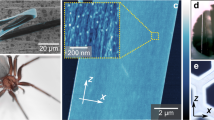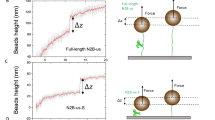Abstract
PARAMYOSIN, a fibrous protein which has so far only been found in the muscles of invertebrates, gives an X-ray pattern with sharp 1.5 and 5.1 Å meridional and diffuse 10 Å near-equatorial reflexions and so is classified with α-keratin, myosin and fibrinogen as an α-fibrous protein. The X-ray patterns of these proteins differ, however, in the low-angle region where the pattern may be indexed on a repeat of 198 Å for α-keratin1, 420 Å for striated muscle2, 226 Å for fibrinogen3 and 725 Å for paramyosin4. The only one of these low-angle patterns which is clearly understood is that of paramyosin which may be interpreted in terms of either the two-dimensional net shown in Fig. 1(a) or a helix5. Electron micrographs have shown a two-dimensional pattern of spots6 similar to the lattice in Fig. 1(a) where the axial repeat is 725 Å, and this is reduced to 145 Å in axial projection (Fig. 1(b)). This communication reports a pseudo-repeat of 29 Å in axial projection which shows up when the paramyosin is treated with silver.
This is a preview of subscription content, access via your institution
Access options
Subscribe to this journal
Receive 51 print issues and online access
$199.00 per year
only $3.90 per issue
Buy this article
- Purchase on Springer Link
- Instant access to full article PDF
Prices may be subject to local taxes which are calculated during checkout
Similar content being viewed by others
References
MacArthur, I., Nature, 152, 38 (1943).
Huxley, H. E., Proc. Roy. Soc., B, 141, 59 (1953).
Stryer, L., Cohen, C., and Langridge, R., Nature, 197, 793 (1963).
Bear, R. S. J., Amer. Chem. Soc., 67, 1625 (1945).
Bear, R. S., and Selby, C. C. J., Biophys. Biochem. Cytol., 2, 55 (1956).
Schmitt, F. O., Bear, R. S., Hall, C. E., and Jakus, M. A., Ann. N.Y. Acad. Sci., 47, 799 (1947).
Robertson, J. M., J. Chem. Soc., 1195 (1936).
Robertson, J. M., and Woodward, I., J. Chem. Soc., 219 (1937).
Kendrew, J. C., Dickerson, R. E., Strandberg, B. E., Hart, R. G., Davies, D. R., Phillips, D. C., and Shore, V. C., Nature, 185, 422 (1960).
Bear, R. S., Adv. Protein Chem., 7, 69 (1952).
Fraser, R. D. B., and MacRae, T. P., Nature, 179, 732 (1957).
Fraser, R. D. B., and MacRae, T. P., J. Mol. Biol., 1, 387 (1959).
Hodge, A. J., Proc. U.S. Nat. Acad. Sci., 38, 850 (1952).
Cohen, C., and Holmes, K. C., J. Mol. Biol., 6, 423 (1963).
Cohen, C., and Szent-Györgyi, A. G. J., Amer. Chem. Soc., 79, 248 (1957).
Petruska, J. A., and Hodge, A. J., Proc. U.S. Nat. Acad. Sci., 51, 871 (1964).
Author information
Authors and Affiliations
Rights and permissions
About this article
Cite this article
MILLER, A. Short Pseudo-repeat in Paramyosin. Nature 207, 524–525 (1965). https://doi.org/10.1038/207524a0
Published:
Issue Date:
DOI: https://doi.org/10.1038/207524a0
Comments
By submitting a comment you agree to abide by our Terms and Community Guidelines. If you find something abusive or that does not comply with our terms or guidelines please flag it as inappropriate.



